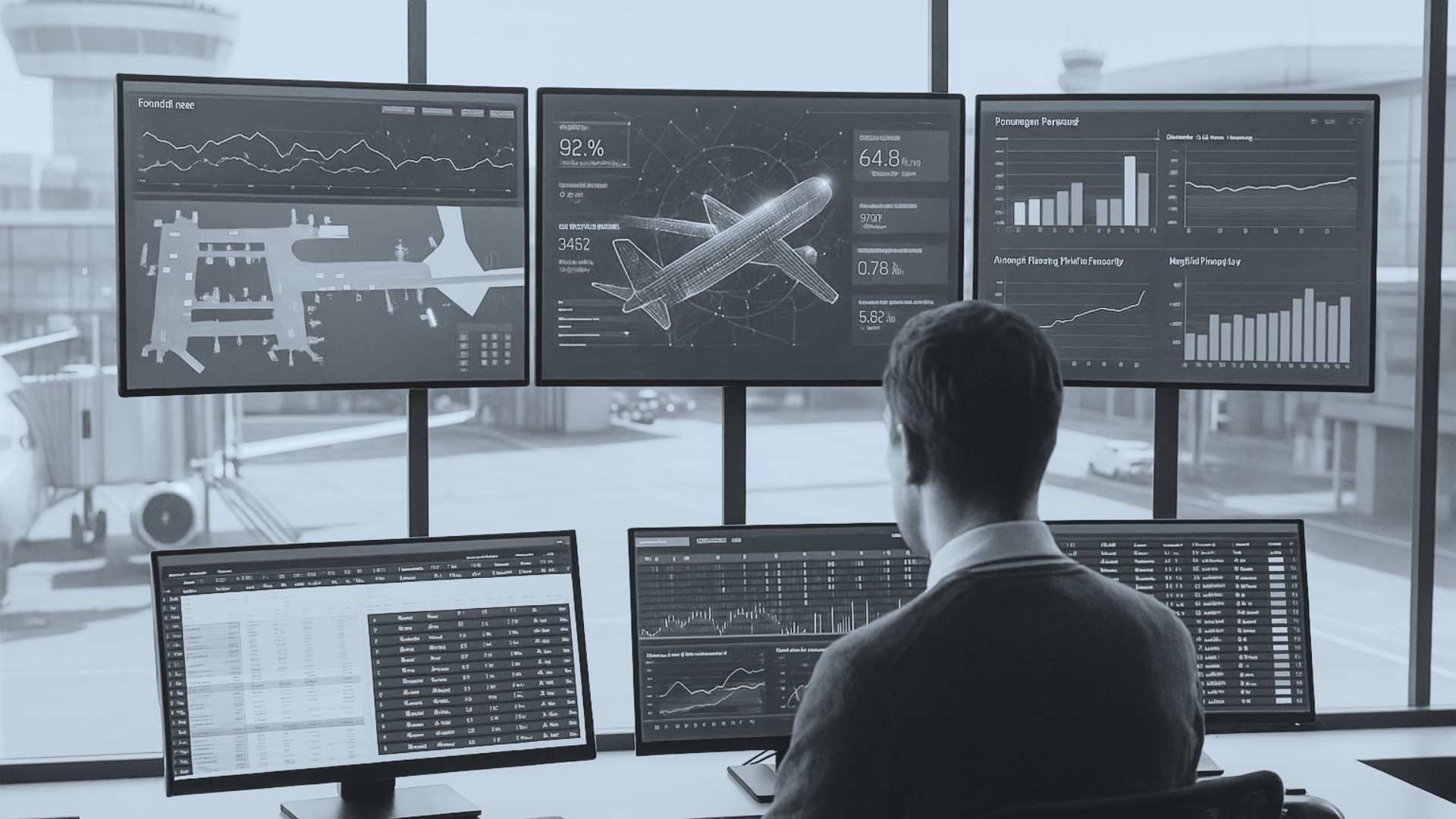Around the world, airports work 24/7 to seamlessly connect travelers to their end destinations. Behind the scenes, a complex web of airport operations management is in constant motion to facilitate travel across the globe.
For anyone involved in the aviation industry, the dynamic nature of the modern airport makes it essential to understand these operations and how they work together to ensure a smooth airport experience.
In this article, we’ll cover what airport operations are, the 4 types of airport operations, and why connected operations are key to ensuring smooth airport operations.
What are airport operations?
The term “airport operations” refers to all the processes and activities that continuously happen inside and around an airport to ensure that the airport experience is as seamless as possible for passengers and staff alike.
Airport operations are divided into four primary divisions. Each of these focuses on different aspects of airport management and services and plays a significant role for airport operations as a whole. Together, they all work to ensure the safe, efficient, and smooth functioning of the airport.
The 4 types of airport operations
As we mentioned above, there are four primary types of airport operations:
- Landside operations
- Airside operations
- Finance, billing, and invoicing
- Information management
While finance, billing, and invoicing are important elements of airport operations, they do not fall within our particular area of expertise. For that reason, we will only cover this area briefly. With that being said, we’ll take a closer look at each type of airport operations below.
1. Landside operations
Landside operations are one of the two main areas of airport operations. The term refers to a wide range of activities focused on creating a seamless passenger experience and managing publicly accessible airport assets.
Essentially, landside operations cover all airport areas and activities that take place prior to security screening and are not directly involved with aircraft movement. This includes:
- Terminal management: Airport staff oversee the daily operations within the airport terminals to provide a seamless and efficient passenger experience. This involves managing a wide variety of operations, including check-in, outbound and reclaim baggage handling, flow management, and much more.
- Security and safety operations: Landside operations include focusing on maintaining a safe and secure environment for both passengers and staff while simultaneously ensuring effective processes, optimized use of infrastructure and staff, and reduced risk of unnecessary queues.
- Queue management: Queue management is an important aspect of managing passenger demand, reducing wait times, and improving operational efficiency. Many airports have introduced virtual queuing to optimize their queue management and offer passengers an enhanced airport experience.
- Ground transportation services: Terminals are typically connected to various ground transportation services, such as buses, taxis, airport shuttles, and rental cars. Landside operations involve effective management of these services to reduce turnaround times.
- Parking operations: Depending on the airport size and traffic, the demand for parking can vary greatly. That makes overseeing parking operations essential to providing a smooth airport experience.
- Customer service delivery: To enhance the passenger experience, an important aspect of landside operations is implementing tools and services to ensure that passenger needs are met within airport lounges, hotels, and other facilities.
Because landside operations play such an essential role in the passenger experience, it’s crucial for landside staff to be able to adapt to the dynamic needs of the modern airport and ensure smooth airport operations and a seamless experience across passenger touchpoints.
The most forward-thinking airports work to collect these touchpoints in a digital marketplace where everything is easily accessible for passengers, creating an encompassing overview and ensuring that all relevant processes are connected.
2. Airside operations
The other main area of airport operations is airside operations. This area covers all activities that occur in the security restricted area of an airport where aircraft are parked, loaded, unloaded, refueled, and prepared for takeoff and landing.
More specifically, airside operations include:
- Aircraft parking and stand/gate allocation: In airports, aircraft movement is key. That makes efficiently managing stand and gate allocation vital for maximizing stand utilization, minimizing congestion at the gates, reducing unnecessary fuel burn, and maintaining tight schedules while avoiding groundside logjams.
- Baggage management: Baggage management involves the transportation, loading, and unloading of passengers’ bags from check-in to aircraft and from aircraft to baggage reclaim. It’s an essential part of preventing delays and lost baggage, and it often involves coordination between multiple teams.
- Border control and immigrations: In airports, border control and immigration management are critical for maintaining national security. These operations involve the checks and procedures required for passengers entering or leaving a country and focus on ensuring lawful entry and exit and preventing illegal activities such as smuggling.
- Stakeholder communication: In airside operations, stakeholder communication refers to the coordination between various entities involved in the operation of an airport, including airlines, ground handling companies, airport authorities, security teams, and customs and immigration services. Effective communication between these entities is crucial for ensuring seamless operations, avoiding delays, and responding quickly to any disruptions. Airports must always be able to quickly adjust to changes on the go, increasing the demand for real-time information sharing and effective communication processes.
- Deicing operations: Deicing is an essential part of ensuring aircraft safety and maintaining efficient flight operations in cold climates. Airports must have designated de-icing zones, and operations are typically carried out under strict safety and environmental regulations.
- Passenger bussing operations: Passenger bussing operations ensure that passengers are transported safely and efficiently between the terminal and the aircraft. Buses are often provided by the airport or ground handling teams and must operate in coordination with the flight schedule to ensure passengers are transferred safely in a timely manner without causing delays.
Ensuring that every one of these areas runs smoothly is vital to maintaining safe and efficient airside operations. When changes occur in one area, they’re likely to affect other areas of operations. This makes it crucial for airport operations to be connected to create a holistic overview and optimize airport operations across all areas.
3. Billing and invoicing
Though not one of the two main areas, billing and invoicing are still essential aspects of airport operations. Billing and invoicing operations handle both aeronautical and non-aeronautical revenue, both of which are vital for the financial health of the airport itself and the overall airport operations.
Billing and invoicing operations include:
- Invoice management: The primary function of billing and invoicing is processing and recording costs associated with flight operations. These include landing fees, fuel charges, and service fees.
- Sales and cash flow monitoring: Billing and invoicing includes monitoring all sales transactions at the airport. This covers everything from food services to retail outlets,
- Payroll management: Staff compensation is an important aspect of airport operations. Billing and invoicing includes ensuring that airport staff are compensated correctly and on time.
- Records and reporting: To support strategic financial planning and ensure compliance with financial regulations, the billing and invoicing division maintains detailed records of all financial transactions across airport operations.
Billing and invoicing ensures that all financial aspects of airport operations are handled precisely and efficiently, supporting the broader goals of commercial aviation.
4. Information management
The final type of airport operations is information management — a pivotal function that ensures all flight and airline communication data is accurately collected and distributed. The bigger the airport, the more important it is to ensure precise, efficient information management.
Information management covers a wide range of activities, including:
- Communication with airlines and handling agents: Information management oversees the systems that enable continuous communication with airlines, handling agents, and other operational stakeholders, facilitating efficient operational adjustments and emergency responses.
- Information collection: Information management handles the daily collection and recording of information essential for maintaining up-to-date and reliable flight data for airport managers and passengers alike.
- Real-time information sharing: To facilitate efficient operations and minimize delays, information sharing in real-time is responsible for ensuring that accurate information reaches all relevant parties — including airlines, passengers, and ground handlers — in real time.
- Situational awareness support: Information management provides real-time updates and alerts on flight statuses and other crucial information, enhancing the overall safety and efficiency of airport operations by maintaining a high level of situational awareness among airport staff.
- Operational optimization: Information management employs systems to continuously analyze data and improve future planning and resource allocation.
Accurate information distribution is integral to airport operations. It supports the timeliness and logistical needs of operations, as well as the organization of the entire flight schedule. By reducing uncertainties and improving reliability across airport services, it also enhances the overall passenger experience — a crucial element of ensuring smooth airport operations.
Why connection is key to ensuring smooth airport operations
For any airport, each operational area above is integral to operations. Staff and passengers alike rely on each type of airport operations to run smoothly. For that reason, connected operations are crucial across areas.
Traditionally, airport operations are conducted in silos. Areas within the various operations are operated separately, making it difficult for areas to adapt and optimize dynamically to changes in real time. To optimize operations in the modern airport, their core operations can no longer be conducted in silos: they must be connected.
For this exact purpose, Copenhagen Optimization has developed Better Airport®: a cloud-based airport operations management SaaS platform that gives all airports, regardless of size, a simpler way to run core operations. It’s the solution that allows you to get the most out of your resources — be it your infrastructure or your staff allocation.
As a common operating platform, the system enables everyone you collaborate with, internally and externally, to easily access and use all functionality. Featuring nine core modules for airport optimization, Better Airport allows airports to mix and match modules to create a solution perfectly suited to the specific needs of the individual airport.
Every module can be connected, making it easy to forecast, understand, and plan passenger and baggage flows throughout the airport. We call this way of working Connected Operations — and we believe it’s the future of airport operations.
Read more about Better Airport ® here.
Enter the future of airport operations with Copenhagen Optimization
Imagine an airport where your operations are connected; an airport where the passenger experience isn’t marked by stress and unnecessary delays, but instead centers around excitement for the journey ahead. At Copenhagen Optimization, we want to help you achieve just that.




